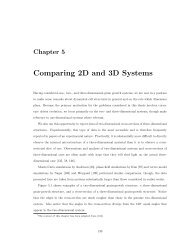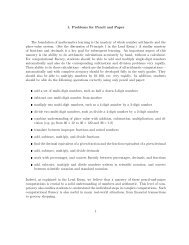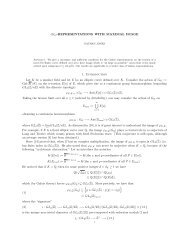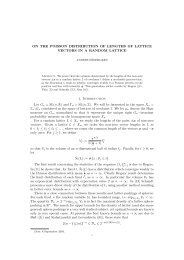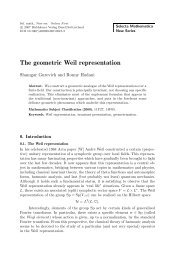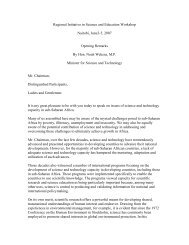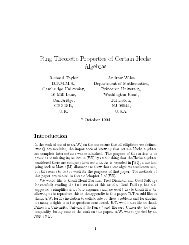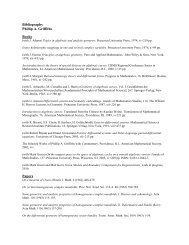Create successful ePaper yourself
Turn your PDF publications into a flip-book with our unique Google optimized e-Paper software.
A CONVERSE TO HALÁSZ’S THEOREM<br />
MAKSYM RADZIWI̷L̷L<br />
Abstract. We show that the distribution of large values of an additive function on the<br />
integers, and the distribution of values of the additive function on the primes are related <strong>to</strong><br />
each other via a Levy Process. As a consequence we obtain a <strong>converse</strong> <strong>to</strong> an old <strong>theorem</strong><br />
of Halasz [4]. Halasz proved that if f is an strongly additive function with f(p) ∈ {0, 1},<br />
then f is Poisson distributed on the integers. We prove, <strong>converse</strong>ly, that if f is Poisson<br />
distributed on the integers then for most primes p, f(p) = o(1) or f(p) = 1 + o(1).<br />
1. Introduction.<br />
Let g be an strongly additive function (that is, g(mn) = g(m) + g(n) for (m, n) = 1 and<br />
g(p k ) = g(p)). According <strong>to</strong> a model due <strong>to</strong> Mark Kac [6] the distribution of the g(n)’s (with<br />
n x and x large) is predicted by the random variable ∑ px g(p)X p where the X p ’s are<br />
independent Bernoulli random variables with<br />
P(X p = 1) = 1 − P(X p = 0) = 1 p<br />
According <strong>to</strong> this model most g(n)’s cluster around the mean µ(g; x) of ∑ px g(p)X p and<br />
within a constant multiple of B(g; x). Here,<br />
µ(g; x) := ∑ px<br />
g(p)<br />
p<br />
and B(g; x) 2 := ∑ px<br />
g(p) 2<br />
In this paper (a follow up <strong>to</strong> [9]) we investigate the inter-relation between the distribution<br />
of an additive function g on the integers, i.e,<br />
{<br />
}<br />
1<br />
(1)<br />
x · # g(n) − µ(g; x)<br />
n x : ∆<br />
B(g; x)<br />
in the range 1 ∆ ≪ B(g; x) 1−ε , and the distribution of the additive function g on the<br />
primes:<br />
1 ∑ g(p) 2<br />
(2) lim<br />
x→∞ B(g; x) 2 p<br />
p x<br />
g(p) t<br />
for fixed t. Previously this question was considered only in the context of limit <strong>theorem</strong>s<br />
(that is, with ∆ = O(1) in (1)) and in that situation the behavior of (1) is controlled by the<br />
distribution of g(p)/B(g; x) for p x (see [2], p. 12).<br />
We will prove, roughly speaking, that in the range 1 ≤ ∆ ≤ B(g; x) 1−ε , (1) behaves as a<br />
sum of B(f; x) 2 independent and identically distributed random variables if and only if (2)<br />
converges <strong>to</strong> a distribution function for almost all t. Since B(f; x) 2 might not be an integer<br />
1991 Mathematics Subject Classification. Primary: 11N64, Secondary: 11N60, 11K65, 60F10.<br />
The author is partially supported by a NSERC PGS-D award.<br />
1<br />
p
2 MAKSYM RADZIWI̷L̷L<br />
there is some care necessary in defining what it means <strong>to</strong> have “B(f; x) 2 random variables”.<br />
For this reason we first illustrate our results in the special case of the Poisson distribution.<br />
Following the work of Selberg [11] and Sathe [10] (in the case g(p) = 1) and Halasz [4]<br />
(in the general case g(p) ∈ {0, 1}), it is known that if g is a strongly additive function with<br />
g(p) ∈ {0, 1} and B(g; x) → ∞, then<br />
(3)<br />
{<br />
1<br />
x · # n x :<br />
g(n) − µ(g; x)<br />
B(g; x)<br />
uniformly in 1 ∆ o(B(g; x)), where,<br />
Poisson (λ, ∆) :=<br />
}<br />
∆ ∼ Poisson ( B(g; x) 2 ; ∆ )<br />
∑<br />
vλ+ √ λ∆<br />
e −λ · λv<br />
v!<br />
denotes the tail of a Poisson distribution with parameter λ. It is not difficult <strong>to</strong> see that the<br />
condition g(p) ∈ {0, 1} is not strictly necessary for the validity of (3) (for example one could<br />
let g(2) = 10 and (3) would still hold). Indeed, a minor variation on Halasz’s <strong>theorem</strong> [4]<br />
shows that <strong>to</strong> guarantee (3) it is enough <strong>to</strong> have 0 g(p) O(1), B(g; x) → ∞ and<br />
1 ∑<br />
( )<br />
g(p) 2<br />
1<br />
(4)<br />
= δ<br />
B(g; x) 2<br />
1 (t) + O<br />
p<br />
B(g; x) 2<br />
p x<br />
g(p) t<br />
as x → ∞, uniformly in t ∈ R, and where<br />
⎧<br />
⎪⎨ 0 if t < α<br />
1<br />
(5) δ α (t) := if t = α<br />
2<br />
⎪⎩<br />
1 if t > α<br />
Relation (4) roughly asserts that for most primes p, g(p) = o(1) or g(p) = 1 + o(1). It turns<br />
out that a condition such as (4) (perhaps with a weaker error term) is not only sufficient for<br />
(3) but also necessary. This is a special case of our main result (Theorem 2).<br />
Theorem 1. Let g be a strongly additive function. If (3) holds uniformly in 1 ∆ ≪<br />
B(g; x) 1−ε , then, as x → ∞,<br />
1 ∑ g(p) 2<br />
−→ δ<br />
B(g; x) 2<br />
1 (t).<br />
p<br />
for all t ≠ 1.<br />
p x<br />
g(p) t<br />
Both Theorem 1 and the sufficient condition (4) are special cases of more general results<br />
which we will now state. Our proofs build in a fundamental way on Halasz’s paper [4] and<br />
its application <strong>to</strong> large deviations of additive functions developed by Halasz (unpublished,<br />
see [2]) and the Lithuanian school (for example [8]). The main <strong>to</strong>ol underneath these large<br />
deviations results is Cramer’s method [1], first transposed in<strong>to</strong> an arithmetic context by<br />
Kubilius, in [7].<br />
Despite being more technical our main result (Theorem 2 and Theorem 3) has the merit<br />
of making clear the inter-relation between the distribution of the additive function on the<br />
integers and its distribution on the primes. This inter-relation by Levy Processes (in fact a<br />
modified version of that concept) which we now introduce in<strong>to</strong> our discussion.
A CONVERSE TO HALÁSZ’S THEOREM 3<br />
Definition 1. Let Ψ be a distribution function. Suppose that Ψ(α) − Ψ(0) = 1 for some α ><br />
0. We define {Z Ψ (u)} u0 <strong>to</strong> be a sequence of random variables with distribution determined<br />
by<br />
E [ e ] ( ∫ ∞<br />
)<br />
itZ e<br />
Ψ(u) itx − itx − 1<br />
= exp iu ·<br />
· dΨ(x)<br />
0 x 2<br />
for each u 0.<br />
For integer u ∈ N, the random variable Z Ψ (u) can be thought off as a sum of u independent<br />
copies of Z Ψ (1). Thus Z Ψ (u) is a continuous generalization of the notion of a random walk.<br />
Notice also that if Ψ(t) = δ(t), then Z Ψ (u) is a centered Poisson random variable with<br />
parameter u.<br />
Theorem 1 is a particular case (i.e Ψ(t) = δ 1 (t)) of the following result.<br />
Theorem 2. Let g be a strongly additive function with 0 g(p) O(1) and B(g; x) → ∞.<br />
If there is a distribution function Ψ(t) ≠ δ 0 (t) (such that Ψ(α) − Ψ(0) = 1 for some α > 0)<br />
and such that,<br />
(6)<br />
{<br />
1<br />
x · # n x :<br />
g(n) − µ(g; x)<br />
B(g; x)<br />
uniformly in 1 ∆ ≪ B(g; x) 1−ε , then,<br />
(7) lim<br />
x→∞<br />
1<br />
B(g; x) 2<br />
at all continuity points of Ψ(t).<br />
}<br />
∆ ∼ P ( Z Ψ (B(g; x) 2 ) ∆B(g; x) )<br />
∑<br />
p x<br />
g(p) t<br />
g(p) 2<br />
p<br />
= Ψ(t)<br />
The range 1 ≤ ∆ ≪ B(g; x) 1−ε is optimal for the conclusion of the Theorem. In the range<br />
1 ≤ ∆ ≪ B(g; x) α (with α < 1) the left-hand side of (6) depends only on the first k ≤ ⌈ 1+α⌉<br />
1−α<br />
moments<br />
1 ∑ g(p) 2+k<br />
B(g; x) 2 p<br />
p≤x<br />
and thus cannot imply (7) (see [9] for more on this). It is fitting <strong>to</strong> complete Theorem 2<br />
with a result showing that each of the laws Z Ψ (u) does occur as the law of some additive<br />
function (and thus (6) is not vacuous for any Ψ). We show this below.<br />
Theorem 3. Let g be a strongly additive function with 0 g(p) O(1) and B(g; x) → ∞.<br />
If there is a distribution function Ψ(t) ≠ δ 0 (t) with Ψ(α) − Ψ(0) = 1 (for some α > 0) such<br />
that<br />
(8)<br />
1<br />
B(g; x) 2<br />
uniformly in t, then,<br />
{<br />
1<br />
x · # n x :<br />
uniformly in 1 ∆ o(B(g; x)).<br />
∑<br />
p x<br />
g(p) t<br />
g(n) − µ(g; x)<br />
B(g; x)<br />
g(p) 2<br />
p<br />
(<br />
= Ψ(g; t) + O<br />
)<br />
1<br />
B(g; x) 2<br />
}<br />
∆ ∼ P ( Z Ψ (B(g; x) 2 ) ∆B(g; x) )
4 MAKSYM RADZIWI̷L̷L<br />
For each Ψ(t) one can always choose the g(p)’s so that (8) is satisfied. It follows that for<br />
each Z Ψ there is an additive function g whose distribution on the integers is described by<br />
the process {Z Ψ (u)} u0 . In particular the assumption (6) of Theorem 2 is never vacuous.<br />
The conclusion of these two <strong>theorem</strong>s can be subsumed as follows: given an additive<br />
function g, its distribution on the primes Ψ and its distribution on the integers F , a related<br />
through the following correspondance,<br />
{Z Ψ (u)} = F ←→ Ψ(t)<br />
It would be interesting <strong>to</strong> elucidate this connection further, and prove <strong>theorem</strong>s that allow<br />
for a Ψ that varies with x, say,<br />
Ψ x (t) :=<br />
1<br />
B(g; x) 2<br />
∑<br />
p x<br />
g(p) t<br />
g(p) 2<br />
Then the goal would be <strong>to</strong> describe the resulting distribution Z Ψx (B(g; x) 2 ) on the integers<br />
in terms of Ψ x (t), and vice-versa. The questions appearing in this paper have been also<br />
explored in a different context in my paper [9]<br />
2. Integers <strong>to</strong> primes : Proof of Theorem 2<br />
The goal of this section is <strong>to</strong> prove Theorem 2. Throughout we define D f (x; ∆) by<br />
D f (x; ∆) := 1 {<br />
}<br />
x · # f(n) − µ(f; x)<br />
n x : ∆<br />
B(f; x)<br />
2.1. Large deviations for D f (x; ∆) and P(Z Ψ (x) t). We will usually need <strong>to</strong> “adjust”<br />
some of the results taken from the literature. Our main <strong>to</strong>ol will be Lagrange inversion.<br />
Lemma 1. Let C > 0 be given. Let f(z) be analytic in |z| C. Suppose that f ′ (z) ≠ 0 for<br />
all |z| C and that in |z| C the function f(z) vanishes only at the point z = 0. Then, the<br />
function g defined implicitly by f(g(z)) = z is analytic in a neighborhood of 0 and its n-th<br />
coefficient a n in the Taylor expansion about 0 is given by<br />
a n = 1<br />
2πi<br />
∮<br />
γ<br />
ζf ′ (ζ)<br />
dζ<br />
f(ζ)<br />
n+1<br />
where γ is a circle about 0, contained in |ζ| C. The function g(z) is given by<br />
g(z) = 1 ∮<br />
ζf ′ (ζ)<br />
2πi f(ζ) − z · dζ<br />
and again γ is a circle about 0, contained in |ζ| C.<br />
The desired asymp<strong>to</strong>tic for D f (x; ∆) is contained in Maciulis’s paper ([8], lemma 1A).<br />
Lemma 2. Let f be an additive function. Suppose that 0 f(p) O(1) and that<br />
B(f; x) −→ ∞ (or equivalently σ(f; x) → ∞). Let B 2 = B(f; x) 2 . Uniformly in the<br />
range 1 ∆ o(σ(f; x)) we have<br />
(<br />
)<br />
∞∑<br />
∫<br />
D f (x; ∆) ∼ exp − ∆3 λ f (x; k + 2)<br />
∞<br />
· (∆/B) k e −u2 /2 du<br />
· √<br />
B k + 3<br />
2π<br />
k=0<br />
γ<br />
p<br />
∆
A CONVERSE TO HALÁSZ’S THEOREM 5<br />
where the coefficients λ f (x; k) are defined recursively by λ f (x; 0) = 0, λ f (x; 1) = 1 and<br />
(<br />
)<br />
j∑ 1<br />
λ f (x; j) = −<br />
i! · 1 ∑ f(p) i+1 ∑<br />
λ<br />
B(f; x) 2 f (x; k 1 ) · . . . · λ f (x; k i )<br />
p<br />
i=2<br />
px<br />
k 1 +...+k i =j<br />
Further there is a constant C = C(f) such that |λ f (x; k)| C k for all k, x 1.<br />
Proof. Except the bound |λ f (x; k)| C k , the <strong>to</strong>tality of the lemma is contained in Maciulis’s<br />
paper ([8], lemma 1A). Let us prove that |λ f (x; k)| C k for a suitable positive constant<br />
C > 0. To do so, we consider the power series<br />
G f (x; z) = ∑ j2<br />
λ f (x; j) · z j + z<br />
Let us look in more detail at the sum over j 2. By making use of the recurrence relation<br />
for λ f (x; j) we see that the sum in question equals <strong>to</strong><br />
= − ∑ (<br />
)<br />
j∑ 1<br />
i! · 1 ∑ f(p) i+1 ∑<br />
B (f; x) 2 λ f (x; k 1 ) · . . . · λ f (x; k i ) · z j<br />
p<br />
j2 i=2<br />
px<br />
k 1 +...+k i =j<br />
= − ∑ (<br />
) ( ) i<br />
1<br />
i! · 1 ∑ f(p) i+1 ∑<br />
B (f; x) 2 · λ f (x; k) z k<br />
p<br />
i2<br />
px<br />
k0<br />
1 ∑ f(p) ∑ 1<br />
= −<br />
B(f; x) 2 p i! · f(p)i · G f (x; z) i<br />
px<br />
1 ∑<br />
= −<br />
B (f; x) 2<br />
px<br />
f(p)<br />
p<br />
i2<br />
· (e f(p)G f (x;z) − f(p)G f (x; z) − 1 )<br />
The above calculation reveals that F f (x; G f (x; z)) = z where F f (x; z) is defined by<br />
F f (x; z) = z +<br />
=<br />
1 ∑<br />
B(f; x) 2<br />
1 ∑<br />
B(f; x) 2<br />
px<br />
px<br />
f(p)<br />
p<br />
f(p)<br />
p<br />
· (e f(p)z − f(p)z − 1 )<br />
· (e f(p)z − 1 )<br />
Since all the f(p) are bounded by some M 0, we have F f (x; z) = z + O (Mz 2 ) when z is<br />
in a neighborhood of 0, furthermore the implicit constant in the big O, depends only on M.<br />
Therefore F f (x; z) ≫ 1 for z in the annulus B/2 |z| B, where B is a sufficiently small<br />
constant, depending only on M. Let us also note the derivative<br />
d<br />
dz · F f(x; z) =<br />
1 ∑<br />
B(f; x) 2<br />
px<br />
f(p) 2<br />
· e f(p)z<br />
p<br />
doesn’t vanish and is bounded uniformly in |z| B for B sufficiently small, depending only<br />
on M. Hence by Lagrange inversion the function G f (x; z) is for each x 1 analytic in the<br />
neighborhood |z| B of 0, and in addition, its coefficients λ f (x; k) are given by<br />
λ f (x; k) = 1<br />
2πi<br />
∮<br />
|ζ|=B/2<br />
ζ · (d/dζ)F f (x; ζ)<br />
dζ<br />
F f (x; ζ) k+1
6 MAKSYM RADZIWI̷L̷L<br />
However we know that F f (x; ζ) ≫ 1 and that (d/dζ)G f (x; ζ) ≪ 1 on the boundary |ζ| = B/2<br />
with the implicit constant depending only on M. Therefore, the integral is bounded by C k ,<br />
for some C > 0 depending only on M. Hence |λ f (x; k)| C k .<br />
□<br />
From Hwang’s paper [5] – itself heavily based on the same methods as used by Maciulis<br />
[8] – we obtain the next lemma. Since Hwang’s lemma is not exactly what is stated below,<br />
we include the deduction.<br />
Lemma 3. Let Ψ be a distribution function. Suppose that there is an α > 0 such that<br />
Ψ(α) − Ψ(0) = 1. Let B 2 = B 2 (x) → ∞ be some function tending <strong>to</strong> infinity. Uniformly in<br />
the range 1 ∆ o(B) we have<br />
P ( Z Ψ<br />
(<br />
B<br />
2 ) ∆B ) ∼ exp<br />
(<br />
− ∆3<br />
B<br />
∞∑<br />
k=0<br />
Λ(Ψ; k + 2)<br />
k + 3<br />
) ∫ ∞<br />
· (∆/B) k e −u2 /2 du<br />
· √<br />
2π<br />
the coefficients Λ(Ψ; k) satisfy Λ(Ψ; 0) = 0, Λ(Ψ; 1) = 1 and the recurrence relation<br />
Λ(Ψ; j) = − ∑<br />
2lj<br />
∫<br />
1<br />
l! R<br />
t l−1 dΨ(f; t)<br />
∑<br />
k 1 +...+k l =j<br />
∆<br />
Λ(Ψ; k 1 ) · . . . · Λ(Ψ; k l )<br />
Furthermore there is a constant C = C(Ψ) > 0 such that |Λ(Ψ; k)| C k for k 1.<br />
Proof. Let u(z) = u(Ψ; z) = ∫ R (ezt − zt − 1) · t −2 dΨ(t). Note that u(z) is entire because Ψ(t)<br />
is supported on a compact interval. By Hwang’s <strong>theorem</strong> 1 (see [5])<br />
P ( Z Ψ<br />
(<br />
B<br />
2 ) ∆B ) ∼ exp<br />
(<br />
−B 2 ∑ k0<br />
Λ(Ψ; k + 2)<br />
k + 3<br />
) ∫ ∞<br />
· (∆/B) k e −u2 /2 du<br />
· √<br />
2π<br />
uniformly in 1 ∆ o(B(x)) with the coefficients Λ(Ψ; k) given by Λ(Ψ; 0) = 0, Λ(Ψ; 1) = 1<br />
and for k 0,<br />
Λ(Ψ; k + 2)<br />
k + 3<br />
= − 1 ∮<br />
k + 3 · 1<br />
2πi<br />
= − 1 ∮<br />
k + 3<br />
γ<br />
γ<br />
( ) u<br />
u ′′ ′ −k−3<br />
(z) dz<br />
(z) ·<br />
·<br />
z z k+2<br />
zu ′′ (z) dz ·<br />
u ′ (z)<br />
k+3<br />
2πi<br />
(we set m = k + 3, k 0, q m = Λ(Ψ; k + 2)/(k + 3) in equation (7) of [5] and rewrite<br />
equation (8) in [5] in terms of Cauchy’s formula). Here γ is a small circle around the origin.<br />
First let us show that the coefficients Λ(Ψ; k + 2) are bounded by C k for a sufficiently large<br />
(but fixed) C > 0. Around z = 0 we have u ′ (z) = ∫ R (ezt − 1) · t −1 dΨ(t) = z + O(z 2 ).<br />
Therefore if we choose the circle γ <strong>to</strong> have sufficiently small radius then u ′ (z) ≫ 1 for z on<br />
γ. Hence looking at the previous equation, the Cauchy integral defining Λ(Ψ; k + 2)/k + 3 is<br />
bounded in modulus by ≪ C k+3 for some constant C > 0. The bound |Λ(Ψ; k)| ≪ C k ensues<br />
(perhaps with a larger C than earlier). Our goal now is <strong>to</strong> show that Λ(Ψ; k) satisfies the<br />
recurrence relation given in the statement of the lemma. Multiplying by ξ k+3 and summing<br />
∆
over k 0 we obtain<br />
∑<br />
A CONVERSE TO HALÁSZ’S THEOREM 7<br />
Λ(Ψ; k + 2)<br />
k + 3<br />
· ξ k+3 = − ∑<br />
k0<br />
k0<br />
∮<br />
= − zu ′′ (z) ∑<br />
γ<br />
k0<br />
∮ (<br />
= zu ′′ (z) · −<br />
ξ<br />
u ′ (z) − 1 2 ·<br />
γ<br />
ξ k+3 ∮<br />
k + 3 γ<br />
( ) k+3<br />
1 ξ<br />
k + 3 ·<br />
· dz<br />
u ′ (z) 2πi<br />
zu ′′ (z) dz ·<br />
u ′ (z)<br />
k+3<br />
2πi<br />
(<br />
ξ 2<br />
u ′ (z) − log 1 − ξ<br />
2 u ′ (z)<br />
))<br />
· dz<br />
2πi<br />
Differentiating with respect <strong>to</strong> ξ on both sides yields<br />
G Ψ (ξ) = ∑ ∮ ( ) zu<br />
Λ(Ψ; k + 2)ξ k+2 ′′ (z)<br />
=<br />
u ′ (z) − ξ − zu′′ (z)<br />
u ′ (z) − ξzu′′ (z) dz<br />
u ′ (z) 2 2πi<br />
k0<br />
By Lagrange inversion this last integral is equal <strong>to</strong> (u ′ ) −1 (ξ) − 0 − ξ where (u ′ ) −1 denotes<br />
the inverse function <strong>to</strong> u ′ (z). Hence<br />
∑<br />
(9)<br />
Λ(Ψ; k)ξ k = (u ′ ) −1 (ξ)<br />
k0<br />
Let us compose this with u ′ (·) on both sides and compute the resulting left hand side. First<br />
of all we expand u ′ (z) in a power series. This gives<br />
∫<br />
u ′ e zt − 1<br />
(z) = dΨ(t) = ∑ ∫<br />
1<br />
t l−1 dΨ(t) · z l<br />
R t<br />
l!<br />
l1<br />
R<br />
Therefore, composing (9) with u ′ (·) yields<br />
( )<br />
∑<br />
ξ = u ′ Λ(Ψ; k)ξ k = ∑<br />
k0<br />
l1<br />
= ∑ ∫<br />
(<br />
1<br />
∑<br />
t l−1 dΨ(t) ·<br />
l!<br />
l1<br />
R<br />
= ∑ ( ∑<br />
∫<br />
1<br />
t l−1 dΨ(t)<br />
l!<br />
m1<br />
R<br />
1lm<br />
k 1 ,...,k l 1<br />
∫<br />
( ) l<br />
1<br />
∑<br />
t l−1 dΨ(t) · Λ(Ψ; k)ξ k<br />
l! R<br />
k0<br />
)<br />
Λ(Ψ; k 1 ) · . . . · Λ(Ψ; k l ) · ξ k 1+...+k l<br />
∑<br />
k 1 +...+k l =m<br />
Λ(Ψ; k 1 ) · . . . · Λ(Ψ; k l )<br />
Thus the first coefficient Λ(Ψ; 1) is equal <strong>to</strong> 1, as desired, while for the terms m 2 we have<br />
∑<br />
∫<br />
1<br />
∑<br />
t l−1 dΨ(t) Λ(Ψ; k 1 ) · . . . · Λ(Ψ; k l ) = 0<br />
l!<br />
1lm<br />
R<br />
k 1 +...+k l =m<br />
The first term l = 1 is equal <strong>to</strong> Λ(Ψ; m). It suffice <strong>to</strong> move it on the right hand side of the<br />
equation, <strong>to</strong> obtain the desired recurrence relation.<br />
□<br />
Finally we will need one last result “from the literature”. Namely a weak form of the<br />
method of moments. For a proof we refer the reader <strong>to</strong> Gut’s book [3], p. 237. (Note<br />
that the next lemma follows from the result in [3] because in our case the random variables<br />
are positive, and bounded, in particular their distribution is determined uniquely by their<br />
moments).<br />
)<br />
· ξ m
8 MAKSYM RADZIWI̷L̷L<br />
Lemma 4. Let Ψ be a distribution function. Suppose that there is an a > 0 such that<br />
Ψ(a) − Ψ(0) = 1. Let F (x; t) be a sequence of distribution functions, one for each x > 0. If<br />
for each k 0,<br />
∫<br />
∫<br />
t k dF(x; t) −→ t k dΨ(t)<br />
Then F (x; t) −→ Ψ(t) at all continuity points t of Ψ(t).<br />
2.2. Proof of Theorem 2.<br />
R<br />
Proof of Theorem 2. By assumptions D f (x; ∆) ∼ P(Z Ψ (B 2 (f; x)) ∆B(f; x)) holds<br />
throughout 1 ∆ o(B(f; x)).<br />
The proof is in three steps. Retaining the notation of Lemma 2 and Lemma 3 we first<br />
show that λ f (k; x) −→ Λ(Ψ; k) for all k 2 (for k = 1 this is trivial). Then, we deduce from<br />
there that<br />
(10)<br />
1<br />
B(f; x) 2<br />
∑<br />
p x<br />
f(p) t<br />
f(p) k+2<br />
p<br />
R<br />
−→<br />
∫<br />
R<br />
t k dΨ(t)<br />
Hence by the method of moments<br />
(11)<br />
1<br />
B(f; x) 2<br />
∑<br />
p x<br />
f(p) t<br />
f(p) 2<br />
p<br />
−→<br />
Ψ(t)<br />
The last step being the easy one. To prove our first step we will proceed by induction on<br />
k 0. We will prove the stronger claim that<br />
(<br />
λ f (x; k + 2) = Λ(Ψ; k + 2) + O k B −2−(k+1))<br />
where we write B = B(f; x) <strong>to</strong> simplify notation. By Lemma 2 and 3, our assumption<br />
D f (x; ∆) ∼ P(Z Ψ (B(f; x) 2 ) ∆B(f; x)) (for 1 ∆ o(B(f; x))) reduces <strong>to</strong><br />
(12) − ∆3<br />
B<br />
∑<br />
m0<br />
λ f (x; m + 2)<br />
m + 3<br />
· (∆/B) m = − ∆3<br />
B<br />
∑<br />
m0<br />
Λ(Ψ; m + 2)<br />
m + 3<br />
· (∆/B) m + o(1)<br />
valid throughout the range 1 ∆ o(σ(f; x)). Let us first establish the base case λ f (x; 2) =<br />
Λ(Ψ; 2) + O(B −1/2 ). In (12) we choose ∆ = B 1/2 . Because of the bounds |λ f (x; m)| C m<br />
and |Λ(Ψ; m)| C m (see lemma 2 and 3) the terms m 1 contribute O(1). The m = 0<br />
term is ≍ B 1/2 . It follows that λ f (x; 2) = Λ(Ψ; 2) + O(B −1/2 ) and so the base case follows.<br />
Let us now suppose that for all l < k, (k 1)<br />
(<br />
λ f (x; l + 2) = Λ (Ψ; l + 2) + O l B −2−(l+1))<br />
Note that we can assume (in the above equation) that the implicit constant depends on k,<br />
by taking the max of the implicit constants in O l (B −2−(l+1) ) for l < k. In equation (12) let’s<br />
choose ∆ = B 1−2−(k+1) . With this choice of ∆ the terms that are k + 1 in (12) contribute<br />
at most<br />
(<br />
∆ 3 /B ) · (C · ∆/B) k+1 ≪ k B 2 · B −3·2−(k+1) · B −(k+1)·2−(k+1)
A CONVERSE TO HALÁSZ’S THEOREM 9<br />
on both sides of (12). On the other hand, we see (by using the induction hypothesis) that<br />
the terms m k − 1 on the left and the right hand side of (12) differ by no more that<br />
( )<br />
∑<br />
− ∆3<br />
B · (∆/B) l<br />
l + 3 · (λ f (x; l + 2) − Λ (Ψ; l + 2))<br />
l
10 MAKSYM RADZIWI̷L̷L<br />
and M f (x; k) → ∫ R tk dΨ(t) (x → ∞) follows. This establishes the induction step and thus<br />
(13) for all fixed l 0. Now we use the method of moments <strong>to</strong> prove that<br />
F (x; t) :=<br />
1<br />
B 2 (f; x)<br />
∑<br />
p x<br />
f(p) t<br />
f(p) 2<br />
p<br />
−→<br />
x→∞<br />
holds at all continuity points t of Ψ(t). Let us note that, the k-th moment of the distribution<br />
function F (x; t), is given by M f (x; k), and as we’ve just shown this converges <strong>to</strong> the the<br />
k-th moment of Ψ(t). That is<br />
∫<br />
R<br />
t k dF (x; t) =<br />
1 ∑ f(p) k+2<br />
B 2 (f; x) p<br />
px<br />
−→<br />
∫<br />
R<br />
Ψ(t)<br />
t k dΨ(t)<br />
Since Ψ(a) − Ψ(0) = 1 for some a > 0, the distribution function Ψ satisfies the assumption<br />
of Lemma 4, hence, by Lemma 4 (the method of moments) we have F (x; t) −→ Ψ(t) at all<br />
continuity points t of Ψ as desired.<br />
□<br />
3. Primes <strong>to</strong> integers: Proof of Theorem 3<br />
We keep the same notation as in the previous section. Namely we recall that,<br />
B 2 (f; x) := ∑ f(p) 2<br />
and D f (x; ∆) := 1 {<br />
}<br />
p<br />
x · # f(n) − µ(f; x)<br />
n x : ∆<br />
B(f; x)<br />
px<br />
We first need <strong>to</strong> modify a little some of the known large deviations results for D f (x; ∆) and<br />
P(Z Ψ (B 2 (f; x)) ∆B(f; x)).<br />
3.1. Large deviations for D f (x; ∆) and P(Z Ψ (x) t) revisited. First we require the<br />
result of Maciulis ([8], <strong>theorem</strong>) in a “saddle-point” version.<br />
Lemma 5. Let g be a strongly additive function such that 0 g(p) O(1) and B(g; x) → ∞.<br />
We have uniformly in 1 ∆ o(B(g; x)),<br />
( ∑ e ηg(p) − ηg(p) − 1<br />
D g (x; ∆) ∼ exp<br />
− η ∑ )<br />
g(p)(e ηg(p) − 1) e ∆2 /2<br />
∫ ∞<br />
√ e −t2 /2 dt<br />
p<br />
p<br />
px<br />
px<br />
2π ∆<br />
where η = η g (x; ∆) is defined as the unique positive solution of the equation<br />
∑<br />
px<br />
g(p)e ηg(p)<br />
p<br />
= µ(g; x) + ∆B(g; x)<br />
Furthermore η g (x; ∆) = ∆/B(g; x) + O(∆ 2 /B(g; x) 2 ).<br />
Proof. Only the last assertion needs <strong>to</strong> be proved, because it is not stated explicitly in<br />
Maciulius’s paper. Fortunately enough, it’s a triviality. Indeed, writing η = η g (x; ∆), we<br />
find that<br />
0 η g (x; ∆) ∑ g(p) 2<br />
∑ g(p)(e ηg(p) − 1)<br />
= ∆B(g; x)<br />
p<br />
p<br />
px<br />
px
A CONVERSE TO HALÁSZ’S THEOREM 11<br />
Dividing by B 2 (g; x) on both sides 0 η g (x; ∆) ∆/B(g; x) follows. Now expanding<br />
e ηg(p) −1 = ηg(p)+O(η 2 g(p) 2 ) and noting that O(η 2 g(p) 2 ) = O(η 2 g(p)) because g(p) = O(1),<br />
we find that<br />
∆B(g; x) = ∑ g(p)(e ηg(p) − 1)<br />
= η ∑ (<br />
g(p) 2<br />
+ O η ∑ )<br />
2 g(p) 2<br />
p<br />
p<br />
p<br />
px<br />
px<br />
px<br />
Again dividing by B 2 (g; x) on both sides, and using the bound η = O(∆/B(g; x)) the claim<br />
follows.<br />
□<br />
Adapting Hwang’s [5] result we prove the following.<br />
Lemma 6. Let Ψ be a distribution function. Suppose that there is an α > 0 such that<br />
Ψ(α) − Ψ(0) = 1. Let B 2 = B 2 (x) → ∞ be some function tending <strong>to</strong> infinity. Then,<br />
uniformly in 1 ∆ o(B(x)) the quantity P (Z Ψ (B 2 ) ∆B) is asymp<strong>to</strong>tic <strong>to</strong><br />
∫<br />
exp<br />
(B 2 e ρu ∫<br />
)<br />
− ρu − 1<br />
dΨ(u) − B 2 e ρu /2<br />
∫<br />
− 1<br />
∞<br />
· ρ dΨ(u) · √ e∆2 e −t2 /2 dt<br />
u 2<br />
u<br />
2π<br />
R<br />
where ρ = ρ Ψ (B(x); ∆) is defined implicitly, as the unique positive solution <strong>to</strong><br />
∫<br />
B 2 e ρu − 1<br />
(x) dΨ(u) = ∆ · B(x)<br />
u<br />
R<br />
Proof. We keep the same notation as in lemma 3. While proving lemma 3 we established<br />
the following useful relationship (see (9))<br />
∑<br />
∫<br />
Λ(Ψ; k + 2)ξ k+2 = (u ′ ) −1 e zt − zt − 1<br />
(ξ) − ξ where u(z) =<br />
dΨ(t)<br />
t 2<br />
k0<br />
Here (u ′ ) −1 denotes the inverse function of u ′ . Integrating the above gives<br />
∑ Λ(Ψ; k + 2)<br />
· ξ k+3 = − ξ2<br />
k + 3<br />
2 + ξ · (u′ ) −1 (ξ) − u((u ′ ) −1 (ξ))<br />
k0<br />
k0<br />
Now choose ξ = ∆/B, then by definition ρ = ρ Ψ (B(x); ∆) = (u ′ ) −1 (ξ). Thus the above<br />
formula becomes<br />
∑ Λ(Ψ; k + 2)<br />
· (∆/B) k+3 = − (∆/B)2 + ∆ ∫<br />
k + 3<br />
2 B · ρ − e ρt − ρt − 1<br />
dΨ(t)<br />
t 2<br />
Also, note that by definition ∆/B = ∫ R (eρt − 1)/t · dΨ(t). Using the above formula (in which<br />
we replace (∆/B) · ρ by ρ ∫ R (eρt − 1)/t · dΨ(t)) and lemma 3<br />
(<br />
P(Z Ψ (B 2 ) ∆B) ∼ exp −B ∑ ) ∫ 2 Λ(Ψ; k + 2)<br />
∞<br />
· (∆/B) k+3 e −u2 /2 du<br />
· √<br />
k + 3<br />
k0<br />
∆ 2π<br />
∫<br />
= exp<br />
(B 2 e ρt ∫<br />
)<br />
− ρt − 1<br />
dΨ(t) − B 2 e ρt /2<br />
∫<br />
− 1<br />
∞<br />
· ρ dΨ(t) · √ e∆2 e −u2 /2 du<br />
R t 2<br />
R t<br />
2π ∆<br />
This is the claim.<br />
□<br />
Before we prove Theorem 3, we need <strong>to</strong> show that the parameters η g (x; ∆) and<br />
ρ Ψ (B(f; x); ∆) (as defined respectively in Lemma 5 and Lemma 6) are “close” when the<br />
distribution of the g(p)’s resembles Ψ(t). The “closeness” assertion is made precise in the<br />
next lemma.<br />
R<br />
R<br />
R<br />
∆
12 MAKSYM RADZIWI̷L̷L<br />
Lemma 7. Let Ψ(·) be a distribution function. Let f be a positive strongly additive function.<br />
Suppose that 0 f(p) O(1) for all primes p. Let<br />
K f (x; t) :=<br />
1<br />
B 2 (f; x)<br />
∑<br />
p x<br />
f(p) t<br />
If K f (x; t) − Ψ(t) ≪ 1/B 2 (f; x) uniformly in t ∈ R, then<br />
f(p) 2<br />
ρ Ψ (B(f; x); ∆) − η f (x; ∆) = o(1/B 2 (f; x))<br />
uniformly in 1 ∆ o(B(f; x)). The symbols ρ Ψ (B(x); ∆) and η f (x; ∆) are defined in<br />
lemma 6 and lemma 5 respectively.<br />
Proof. Let η = η f (x; ∆). Recall that by lemma 5, η = o(1) in the range 1 ∆ o(B(f; x)).<br />
This will justify the numerous Taylor expansions involving the parameter η. With K f (x; t)<br />
defined as in the statement of the lemma, we have<br />
(15)<br />
∑<br />
px<br />
f(p)e ηf(p)<br />
p<br />
− µ(f; x) = ∑ f(p)(e ηf(p) − 1)<br />
p<br />
px<br />
∫<br />
= B 2 e ηt − 1<br />
(f; x) dK f (x; t)<br />
R t<br />
Let M > 0 be a real number such that 0 f(p) M for all p. Since the f(p) are bounded,<br />
for each x > 0 the distribution function K f (x; t) is supported on [0; M]. Furthermore since<br />
K f (x; t) → Ψ(t) the distribution function Ψ(t) is supported on exactly the same interval.<br />
From these considerations, it follows that<br />
∫<br />
e ηt ∫<br />
− 1<br />
M<br />
e ηt − 1<br />
dK f (x; t) =<br />
dK f (x; t)<br />
(16)<br />
=<br />
R<br />
∫ M<br />
0<br />
t<br />
e ηt − 1<br />
dΨ(t) +<br />
t<br />
∫ M<br />
0<br />
p<br />
0 t<br />
(<br />
Kf (x; t) − Ψ(t) ) [ ]<br />
e ηt − ηt · e ηt − 1<br />
· dt<br />
t 2<br />
By a simple Taylor expansion e ηt − ηt · e ηt − 1 = O(η 2 t 2 ). Therefore the integral on the right<br />
hand side is bounded by O(η 2 /B 2 (f; x)). We conclude from (15) and (16) that<br />
∑ f(p)e ηf(p)<br />
∫<br />
(17)<br />
− µ(f; x) = B 2 e ηt − 1<br />
(f; x) dΨ(t) + O ( η 2)<br />
p<br />
t<br />
px<br />
By definition of ρ Ψ and η f ,<br />
∫<br />
(18) B 2 e ρΨ(B;∆)t − 1<br />
(f; x)<br />
dΨ(t) = ∆B(f; x) = ∑ f(p)e η f (x;∆)f(p)<br />
− µ(f; x)<br />
R t<br />
p<br />
px<br />
From (17) and (18) it follows that<br />
∫<br />
(19) B 2 e ρΨ(B;∆)t − e η f (x;∆)t<br />
(f; x)<br />
dΨ(t) = O ( η 2<br />
t<br />
f(x; ∆) )<br />
R<br />
Since Ψ(t) is supported on [0; M] we can restrict the above integral <strong>to</strong> [0; M]. By lemma 5,<br />
we have η f (x; ∆) ∼ ∆/B(f; x) = o(1) in the range ∆ o(B(f; x)). Also 0 ρ Ψ (x; ∆) <br />
R
∫<br />
A CONVERSE TO HALÁSZ’S THEOREM 13<br />
[0;M] (eρ Ψ(x;∆)t − 1)/t · dΨ(t) = ∆/B(f; x) = o(1) for ∆ in the same range. Write ρ :=<br />
ρ Ψ (B; ∆) and η := η f (x; ∆). For 0 t M, we have<br />
(1/t) ( e ρt − e ηt) = (1/t)e ρt · (1 − e (η−ρ)t )<br />
= e ρt · (η − ρ) + O((η − ρ) 2 ) ≍ η − ρ<br />
because ρ = o(1), η = o(1). Inserting this estimate in<strong>to</strong> (19) we get η−ρ = O(η 2 /B 2 (f; x)) =<br />
o(1/B 2 (f; x)) since η 2 = o(1). The lemma is proved.<br />
□<br />
3.2. Proof of Theorem 3.<br />
Proof of Theorem 3. Let notation be as in Lemma 6. Let η = η f (x; ∆) be the parameter<br />
from lemma 5. Proceeding as in the proof of the previous lemma, we get<br />
∑ e ηf(p) ∫<br />
− ηf(p) − 1<br />
= B 2 e ηu − ηu − 1<br />
(20)<br />
(f; x)<br />
dΨ(u) + o(1)<br />
p<br />
u 2<br />
(21)<br />
px<br />
η ∑ px<br />
f(p) · (e ηf(p) − 1)<br />
p<br />
R<br />
∫<br />
= B 2 (f; x)η<br />
R<br />
e ηu − 1<br />
dΨ(u) + o(1)<br />
u<br />
throughout the range 1 ∆ o(B(f; x)). Let ρ := ρ Ψ (B(f; x); ∆) denote the parameter<br />
from Lemma 6. The functions on the right of (10.6) and (10.7) are analytic. Therefore, by<br />
lemma 7,<br />
∫<br />
B 2 e ηu ∫<br />
− ηu − 1<br />
(f; x)<br />
dΨ(u) = B 2 e ρu − ρu − 1<br />
(22)<br />
(f; x)<br />
dΨ(u) + o(1)<br />
u 2 u 2<br />
(23)<br />
R<br />
∫<br />
B 2 (f; x)η<br />
R<br />
e ηu − 1<br />
dΨ(u) = B 2 (f; x)ρ<br />
u<br />
R<br />
∫<br />
R<br />
e ρu − 1<br />
dΨ(u) + o(1)<br />
u<br />
uniformly in 1 ∆ o(B(f; x)). On combining (20) with (22) and (21) with (23) we obtain<br />
∑ e ηf(p) − ηf(p) − 1<br />
− η ∑ f(p)(e ηf(p) − 1)<br />
p<br />
p<br />
px<br />
px<br />
∫<br />
= B 2 e ρu ∫<br />
− ρu − 1<br />
(f; x)<br />
dΨ(u) − B 2 (f; x)ρ<br />
u 2<br />
R<br />
By lemma 5, lemma 6 and the above equation, we get<br />
D f (x; ∆) ∼ P ( Z Ψ<br />
(<br />
B 2 (f; x) ) ∆B(f; x) )<br />
R<br />
e ρu − 1<br />
dΨ(u) + o(1)<br />
u<br />
uniformly in 1 ∆ o(B(f; x)) as desired.<br />
□<br />
Acknowledgements. This is part of author’s undergraduate thesis, written under the<br />
direction of Andrew Granville. The author would like <strong>to</strong> thank first and foremost Andrew<br />
Granville. There is <strong>to</strong>o much <strong>to</strong> thank for, so it is simpler <strong>to</strong> note that this project would not<br />
surface without his constant support. Also, the author would like <strong>to</strong> thank Philippe Sosoe<br />
for proof-reading a substantial part of the old manuscript of this paper.
14 MAKSYM RADZIWI̷L̷L<br />
References<br />
[1] H. Cramer. Sur un nouveau théoréme-limite de la théorie des probabilités. Actualités Scientifiques et<br />
Industrielles, 736:5 – 23, 1938.<br />
[2] P. D. T. A. Elliott. Probabilistic Number Theory. Vol II. Central limit <strong>theorem</strong>s. Springer-Verlag, 1980.<br />
[3] A. Gut. Probability : A graduate course. Springer-Verlag, 2005.<br />
[4] G. Halász. On the distribution of additive and the mean-values of multiplicative arithmetic functions.<br />
Studia. Sci. Math. Hungarica., 6:211 – 233, 1971.<br />
[5] H.-K. Hwang. Large deviations for combina<strong>to</strong>rial distributions. i. central limit <strong>theorem</strong>s. Ann. Appl.<br />
Probab., 6 no. 1:297 – 319, 1996.<br />
[6] M. Kac. Statistical Independance in Probability, Analysis, and Number theory. Mathematical Association<br />
of America, 1959.<br />
[7] J. Kubilius. Probabilistic methods in the theory of numbers. 1964.<br />
[8] A. Maciulis. A lemma on large deviations. Lithuanian. Mat. Journal, 23 no. 1:70 –78, 1983.<br />
[9] M. Radziwi̷l̷l. On a structure <strong>theorem</strong> in probabilistic number theory. pre-print, 2011.<br />
[10] L. G. Sathe. On a problem of hardy on the distribution of integers having a given number of prime<br />
fac<strong>to</strong>rs. ii. J. Indian Math. Soc. (N.S.), 17:83 – 141, 1953.<br />
[11] A. Selberg. Note on a paper by l. g. sathe. J. Indian Math. Soc. (N.S.), 18:83 – 87, 1954.<br />
Department of Mathematics, Stanford University, 450 Serra Mall, Bldg. 380, Stanford,<br />
CA 94305-2125<br />
E-mail address: maksym@stanford.edu



